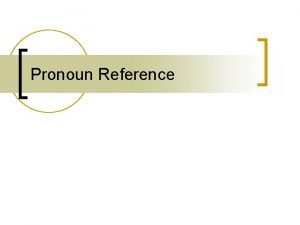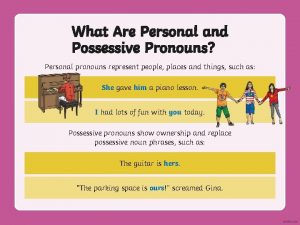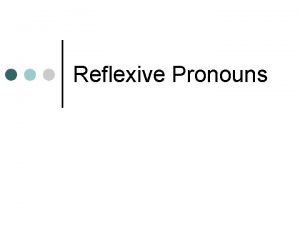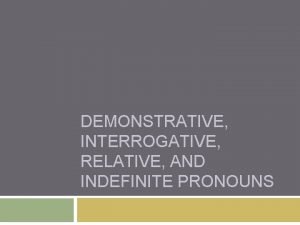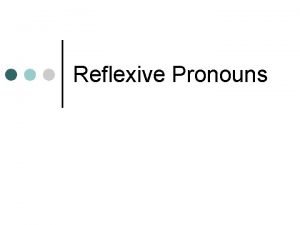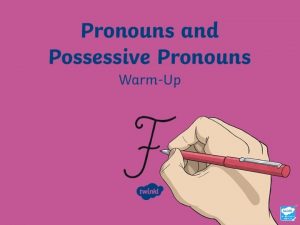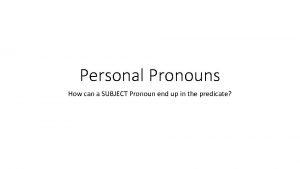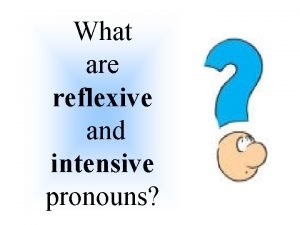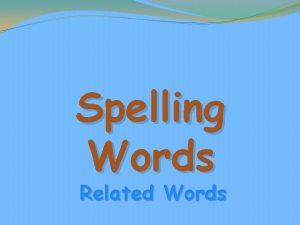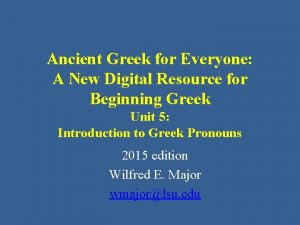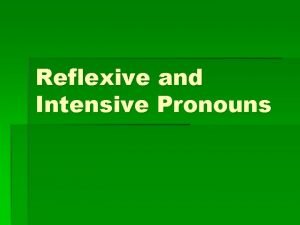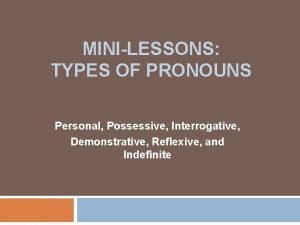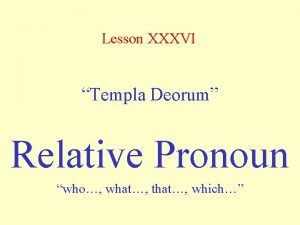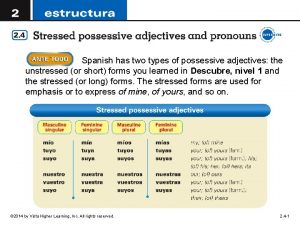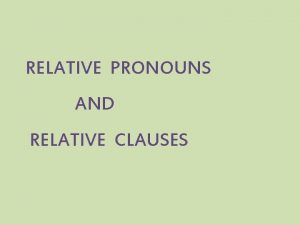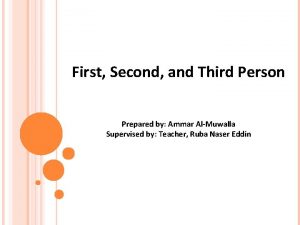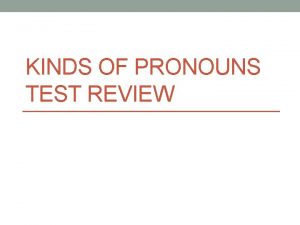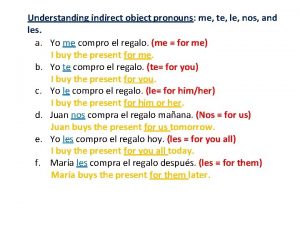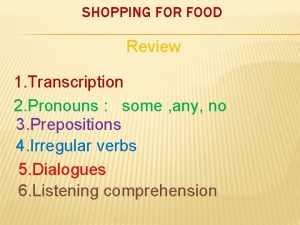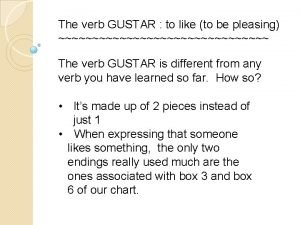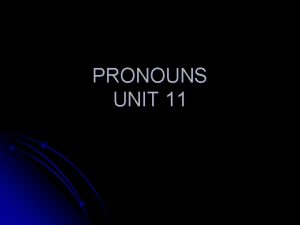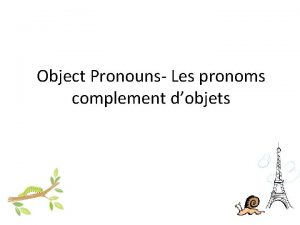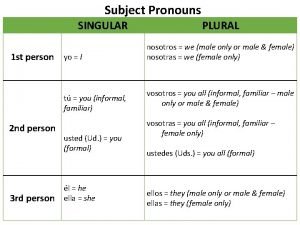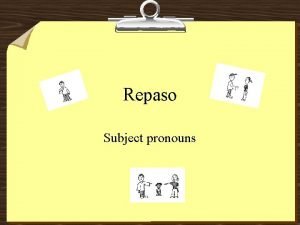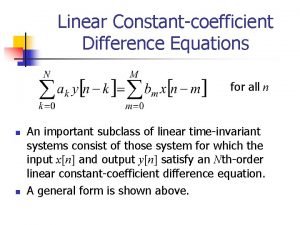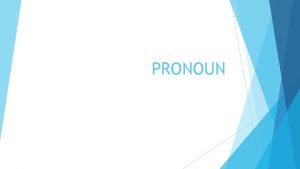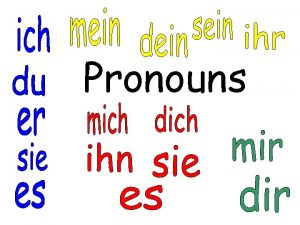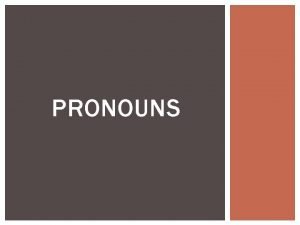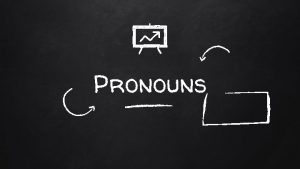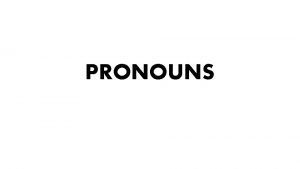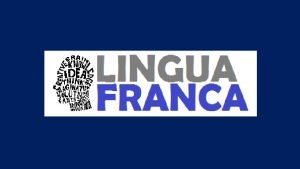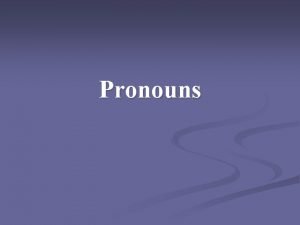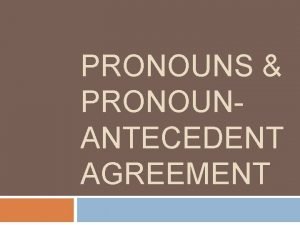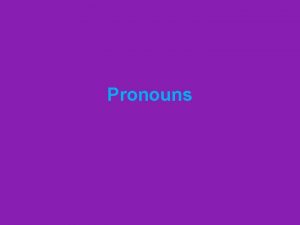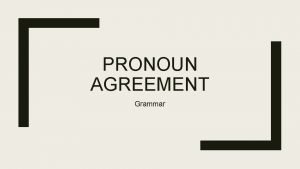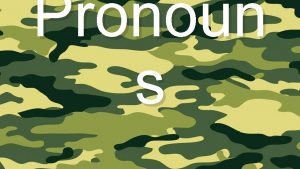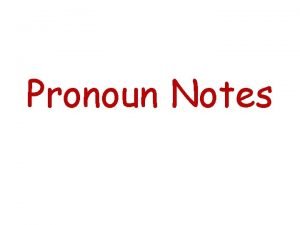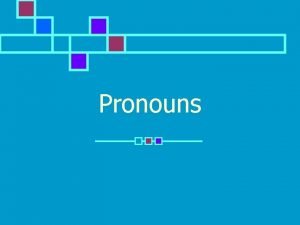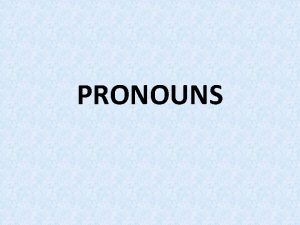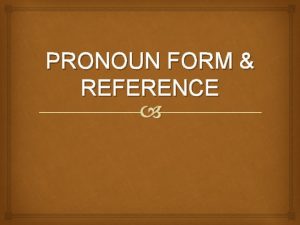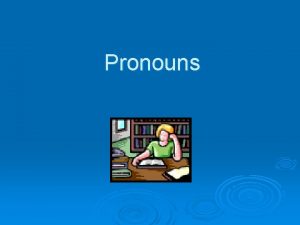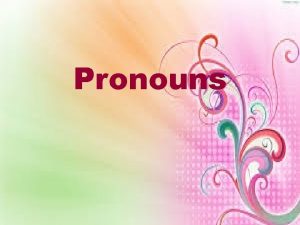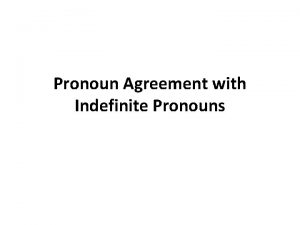Pronouns What is a pronoun A pronoun is
































- Slides: 32

Pronouns

What is a pronoun? A pronoun is a word which is used in the place of a noun or another pronoun. The word which a personal pronoun refers to is called the antecedent. Ex: I, you, me, she, they, mine

What is a pronoun? Personal pronouns change their form to reflect person, number, and case. Person- personal pronouns have different forms for first, second, and third person. Number- pronouns can be singular or plural Case- personal pronouns change their form depending on how they are used in a sentence. Each pronoun has 3 cases: subject, object, and possessive.

Personal Pronouns What is a personal pronoun? (Glue into your binder. ) A word which refers to the one speaking (1 st person), the one spoken to (2 nd person), or the one spoken about (3 rd person).

Pronouns Singular First person- I, me, my, mine Second person- you, yours Third Person- he, she, it, him, her, his, hers, its Plural First person- we, us, ours Second person- you, yours Third person- they, them, theirs

Guided Practice: Identify Have the pronoun within each sentence. you ever heard of the Underground Railroad? The slaves traveled by night with their few possessions. He helped more than 3, 000 slaves escape. It was a long, dangerous journey.

Practice: Write each sentence in your notes. Underline the personal pronoun in each sentence. It played an important part in our history. Mary’s parents built her a new photography lab. She thanked them for what they had done. It was a long, tedious task.

Pronoun Antecedents What is a pronoun antecedent? (Glue into your binder. ) What the pronoun is referring to. Example: Brendan ate his candy. (His is referring to Brendan. )

Guided Practice What is my pronoun? What is the antecedent? Jordan went to the store, and he bought the new video game. If the escaped slaves were caught, they would be sent back to their masters. Returned slaves knew terrible punishments awaited them. Glue the practice sheet underneath your definition. Answer with your shoulder partner.

Subject Pronouns A subject pronoun is used as the subject of a sentence or as a predicate pronoun after a linking verb. Singular subjects- I, you, he, she, it Plural subjects- we, you, they Sixth graders helped with the art fair. They worked extremely hard. (They replaces Sixth graders)

Identifying Subject Pronouns Ms. Edmond’s class and I will collect the art. We will label each drawing entered into the fair. Will you help? We keep the easels in the storage room. After the easels are arranged, you and she may help with the other jobs.

Object Pronouns Object pronouns are personal pronouns used as direct objects, as indirect objects, or as the objects of prepositions. Singular objects- me, you, him, her, it Plural objects- us, you, them

Identifying Object Pronouns Matt’s family is large, and he takes many pictures of them. He gives them pictures for their photo albums. When he visited downtown, he gave it a try. Later he showed me some of the pictures he had shot. She learned them by herself.

Possessive Pronouns What is a possessive pronoun? (Glue into your notes. ) Possessive pronouns are pronouns used to show ownership or a relationship. Singular possessive: my, mine, yours, hers, his, its Plural possessive: our, ours, yours, theirs

Possessive Pronouns The possessive pronouns my, your, her, his, our, and their come BEFORE nouns. Mine, ours, yours, hers, and theirs can STAND ALONE within a sentence. REMEMBER, apostrophes possessive pronouns NEVER use

Guided Practice Identify the possessive pronouns in each sentence. All of us have our special talents and abilities. For example, Mozart was a musical genius. His father had him perform at a child before the kings of Europe. Mozart’s musical talent was great, but what is your special ability? Glue the practice sheet into your binder and complete.

Reflexive and Intensive Pronouns Singular 1 st person- myself 2 nd person- yourself 3 rd person- herself, himself, itself Plural 1 st person- ourselves 2 nd personyourselves 3 rd personthemselves

Reflexive Pronouns A reflexive pronoun refers to the subject and directs the action of the verb back to the subject. These pronouns are necessary to the meaning of the sentence. The emperor convinced himself the cloth was beautiful.

Intensive Pronouns An intensive pronoun emphasize the noun or the pronoun within the same sentence. These are NOT necessary to the meaning of the sentence. I myself would have laughed at the sight.

Guided Practice When I feel discouraged, I tell myself the story of the ugly duckling. The ugly duckling himself could not understand why no one liked him. Because he was different, the other ducklings saw themselves as better than him.

Independent Practice Copy the sentences into your binder. Underline the pronoun and label as intensive or reflexive. The ugly duckling thought, I need to hide myself away from the others. After the winter, the ugly duckling caught a glimpse of himself in the water. He saw himself for what he really was- a beautiful swan. The queen talked herself into punishing Snow White. The owners themselves said they were the Seven Dwarves.

Interrogative Pronouns An interrogative pronoun is used to introduce a question. Whom What Which Whose

Who vs. Whom Who is always used as a subject or as a predicate pronoun. Who created this dance? (Subject) The dancer was who? (Predicate pronoun) Whom is always used as an object. Whom do you choose for your partner? (Direct object) Paula taught whom the new dance? (indirect object) With whom will I dance next? (object of a preposition)

Guided Practice (Who, whom) won the championship last year? To (who, whom)did you give an invitation to? You gave (who, whom) the combination to the safe? (Who, whom) makes the best apple strudel?

Demonstrative Pronouns A demonstrative pronoun points out a person, place, thing, or idea. This, that, these, those Singular- This is my bedroom. Plural- These are my pillows, but those belong to my sister.

Demonstrative Pronouns A demonstrative pronoun are used alone in a sentence. NEVER use here or there with a demonstrative pronoun. These here apples are delicious. Those there pears are juicy.

Guided Practice (That, those) are the cherries which taste sweet. (That, those) are the dogs who howl all night. (This, these) is the most expensive necklace I own. (This here, this) is the house where I live.

Indefinite Pronouns An indefinite pronoun DOES NOT refer to a specific person, place, thing, or idea. Most often indefinite pronouns will not have an antecedent. These pronouns can be singular, plural, or both. (Glue the chart into your binder. )

Using Indefinite Pronouns Use a singular pronoun to refer to a singular indefinite pronoun. Use his or her when the antecedent could be masculine or feminine. Everyone made his or her own costume. (Everyone could be masculine or feminine. )

Using Indefinite Pronouns Use a plural personal pronoun to refer to a plural indefinite pronoun. Several designed their costumes. (Several is plural and their is plural. )

Using Indefinite Pronouns Some indefinite pronouns can be singular or plural. Often, the phrase which follows the pronoun will determine if it is singular or plural. All of the excitement had reached its peak. (All is singular because its is singular. ) All of the audience members took their seats. (All is plural because their is plural. )

Guided Practice Determine the indefinite pronoun used and then select the correct pronoun in parenthesis. All of the students can tell you (his or her, their) reason for enjoying reading. Each of the classes chooses the novel (they, it) will read. None of the students forgot (his or her, their) book at home. All of the students read (his or her, their) books without being reminded.
 A list of pronouns
A list of pronouns Subject pronouns and object pronouns exercises
Subject pronouns and object pronouns exercises Relative pronoun as possessive
Relative pronoun as possessive Personal and possessive pronoun
Personal and possessive pronoun Object pronouns and reflexive pronouns
Object pronouns and reflexive pronouns Reciprocal and reflexive pronouns
Reciprocal and reflexive pronouns Pronouns interrogative relative demonstrative indefinite
Pronouns interrogative relative demonstrative indefinite Reflexive pronouns definition
Reflexive pronouns definition Personal and possessive pronouns
Personal and possessive pronouns Interrogative and demonstrative pronouns
Interrogative and demonstrative pronouns Subject object pronouns possessive adjectives
Subject object pronouns possessive adjectives Personal pronouns complement
Personal pronouns complement The meaning of reflexive pronoun
The meaning of reflexive pronoun Poems with indefinite pronouns
Poems with indefinite pronouns Demonstrative adjectives
Demonstrative adjectives Ancient pronouns
Ancient pronouns Reflexive and intensive pronouns
Reflexive and intensive pronouns Personal possessive demonstrative pronouns
Personal possessive demonstrative pronouns Relative pronoun latin
Relative pronoun latin Stressed possessive adjectives and pronouns
Stressed possessive adjectives and pronouns Relative clauses examples
Relative clauses examples Talking in third person example
Talking in third person example Examples of defining and non defining clauses
Examples of defining and non defining clauses Fill in the blanks with suitable interrogative pronouns
Fill in the blanks with suitable interrogative pronouns Me, te, le, nos les
Me, te, le, nos les Pronouns for food
Pronouns for food Me gustan los tacos
Me gustan los tacos Cases of pronoun
Cases of pronoun Ordre pronoms febles
Ordre pronoms febles Singular subject pronouns
Singular subject pronouns Demonstrative pronouns vs adjectives
Demonstrative pronouns vs adjectives Subject pronouns definition
Subject pronouns definition Xe xir pronouns
Xe xir pronouns
